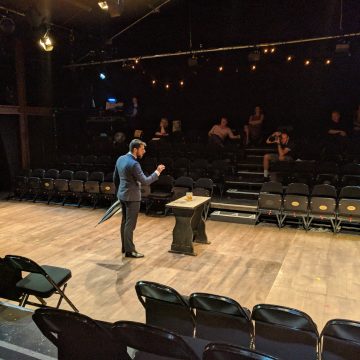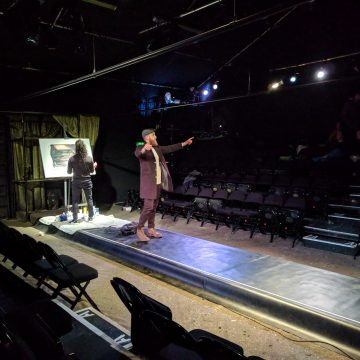3 Experiments with Presence
Southward Playhouse, London
The WHAT [presence]:
New writing, 3 short plays directed at Southwark Playhouse part of Directors’ Cut showcase in 2019.
- Eddie’s Encounter by Jayne Woodhouse performed by Rom Blanco — August 2019
A brief encounter between two former East End partners in crime. However only Eddie is present on stage.
- 43 Quintillion and One by Matt Wixey performed by Linda McDade — October 2019
A daughter visiting her absent ‘bastards dad’ in hospital after a stroke. However, only she is aware they are sharing a space and a chat after such a long time.
- Everything Must Go by Pete Talman performed by Matt Hunter — October 2019
A guy wakes up homeless in West End and decides to sell everything he’s got. However, does anyone see him? is anyone buying?
The WHY [presence]:
Looking at the actor’s process should there be now even fewer difference between preparing for stage versus preparing for film?… as most London shows in the naturalistic vein suggest. As these short experiments aimed to prove there is more to an actor’s craft on stage than ‘naturalism’… and in some regard that is far removed from the work most actors produce when filmed.
1. In the first example, the protagonist is on stage engaged in a conversation with his interlocutor who is not physically present in the scene. The actor through presence and direction, using eye-line, movement, posture, positioning and speech could convey the presence posture, movement and retort of the 2nd character and their relationship at both ends, in addition to his own. The ultimate goal is for the audience to enjoy 2 characters, their individuality and relationship as conveyed by the protagonist. The soundtrack was there to add a sense of rhythm and suspense to the space.
2. In the second example, the protagonist visits her dad who is in a deep coma therefore absent and so the interlocutor didn’t need to be on stage. The monologue of the protagonist is triggered by this situation. However the protagonist and direction have to convey through her presence, subtlety in attitude, fixed eye-line and movement into space the existence of the character who exists in her memory in a different state – the opposite of what is suggested on stage – the character who tormented her for years. The audience is asked to visualise the dynamic of a relationship and the contrasting psychologies to understand the decision of the protagonist by the bedside in its familial complexity, not just as revenge. The soundtrack underlines the absence of an intelocutor but their presence in the room – which is absorbed by the protagonist gradually.
3. In the third example, the audience could become an involved interlocutor to the level it chooses to – the exploration and interaction occurs at this level. The situation is meant to resemble a street scene where a homeless man would catch everybody’s eye by proposing to sell himself and his organs. As in 1 the reaction of the audience/interlocutor is something the protagonist has to convey using direction, eye-line, movement, dance and speech. The audience though trapped to listen to the proposition on stage, more importantly has to question its position as interlocutor or detached audience, who may empathise or not with what transpires between the two. The soundtrack is meant to accentuate the detachment and anonymity of the audience as an optional line to be crossed.




